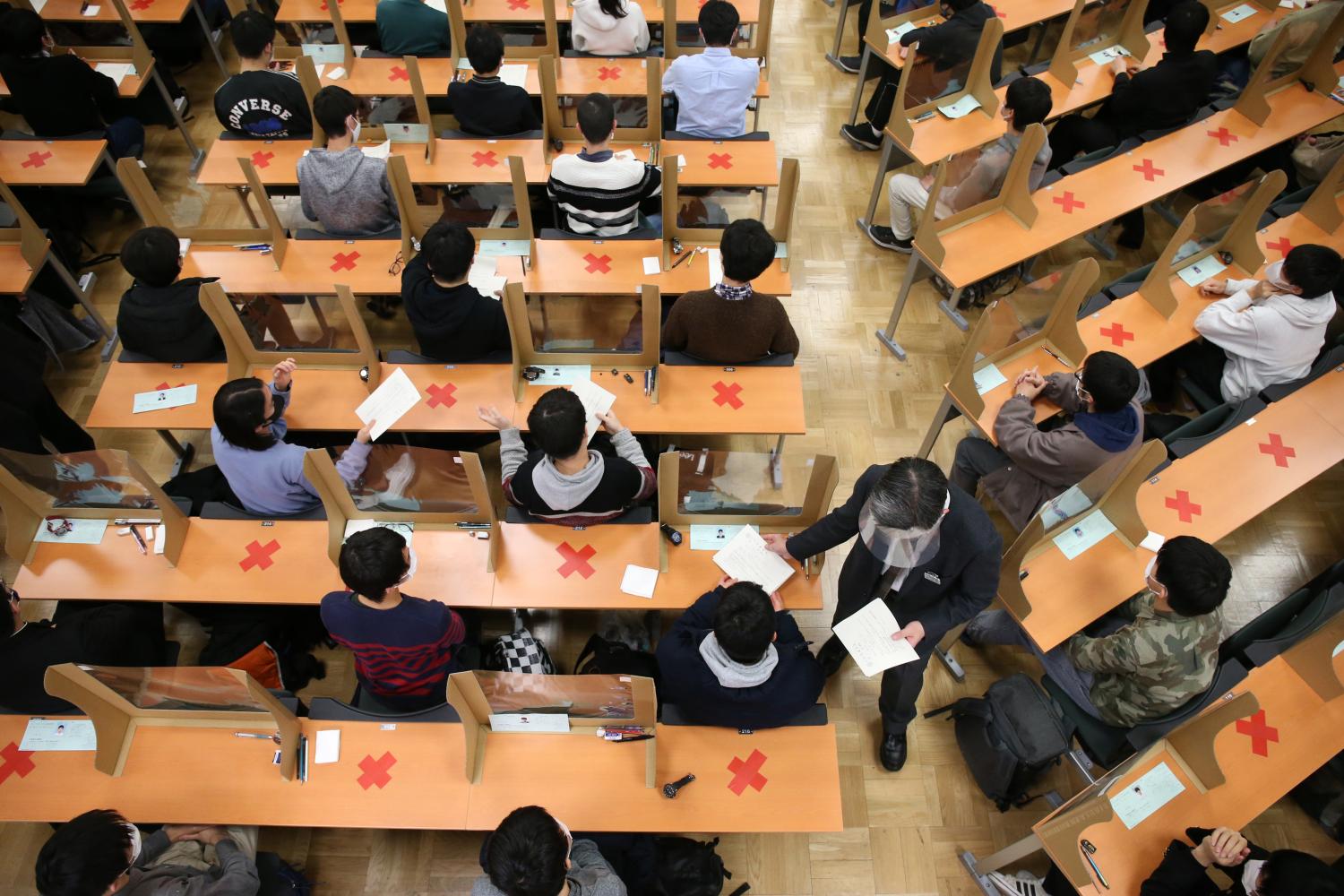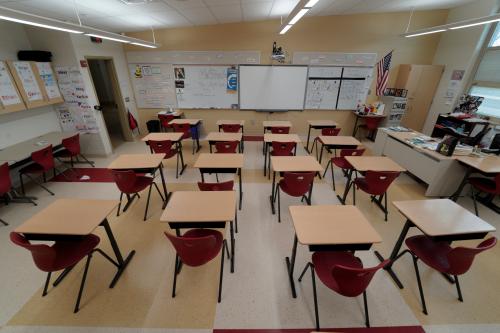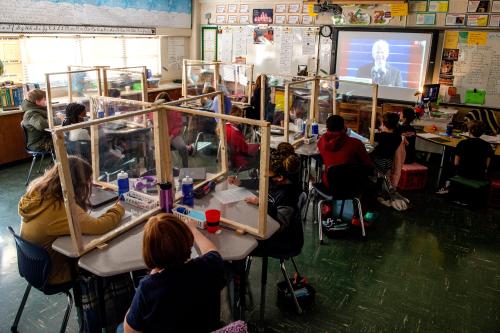The findings in this piece were based on Bureau of Labor Statistics (BLS) data available at the time of publication. However, BLS released substantial revisions to the data on March 11, 2021. Contrary to the earlier data, those revisions suggest that layoffs in public education rose 57% from 2019 to 2020; voluntary “quits” rose 16%; and “other” separations (including death, disability, and retirement) rose 53%. However, even with the revisions, a slowdown in hiring continues to explain a significant portion of the job losses in public education. According to the revised data, layoffs represented about one-third of the total job losses in public education in 2020; higher employee turnover in the form of voluntary “quits” and death, disability, and retirement contributed another third; and the slowdown in hiring accounted for the final third.
Throughout 2020, media accounts were filled with stories about private sector job losses, layoffs, and bankruptcies. According to data from the Bureau of Labor Statistics (BLS), private sector companies employed 7 million fewer workers at the end of 2020 than they had at the start of it, a 6% decline.
On a proportional basis, the job losses were actually larger in the public sector, especially in public education. The same BLS data show that employment fell by 8% at public K-12 schools and 11% in public higher education.
And yet, there were far fewer stories about public sector job losses. My team at the Georgetown University Edunomics Lab, for example, has been tracking school district budget decisions over the last year, and we have not seen many stories of large-scale layoffs in the nation’s biggest school districts.
So, what caused the education job losses? And what do they mean for the $1.9 trillion stimulus bill making its way through Congress?
When I dug into the data, I found that education job losses stem from a slowdown in hiring, not layoffs or a surge in worker turnover. While it may not matter much to the delivery of public education services how the jobs were lost, it does have implications for recovery efforts as Congress contemplates the next round of federal aid.
Job losses are different in the private and public sectors
Both the private and public sectors suffered major job losses last year. Critically, the numbers refer to lost jobs, not people losing their jobs. This is an important distinction, and it varies across private and public employers.
In the private sector, a “lost job” typically means that someone—a person—was put out of work. According to another BLS survey measuring labor turnover, private sector employers laid off more than 35 million workers in 2020, an increase of 81% from 2019.
But the same was not true for public education employees. Public colleges, universities, and K-12 schools laid off fewer workers in 2020 than they did in 2019.
If layoffs weren’t responsible for the missing education jobs, was the decline due to a surge in retirements, as some news stories predicted last summer? No. For public education employees, separations due to retirement, death, and disability declined in 2020.
Were more education employees voluntarily leaving their jobs out of dissatisfaction or in search of better pay? Also no. What the BLS calls the “quit” rate for public education employees fell 27%.
The graph below, using data from the BLS Job Openings and Labor Turnover Survey (JOLTS), shows this discrepancy. The green line represents all private sector employers. The red line represents public colleges, universities, and K-12 school districts. In the private sector, layoffs had a bump in 2009 in response to the last recession and then a much larger spike in 2020.
But public education looks different. It was much lower over the entire period and had a more rounded uptick in 2009-2011. Otherwise, layoffs stayed pretty constant over time. And, as a percentage of all public education employees, there were fewer layoffs in 2020 than in any year since 2001.
Other state and local government employees had similar turnover patterns in 2020, but the numbers are more extreme in education.
So how did public education lose jobs while worker turnover was falling? The answer mainly comes down to slower hiring. State and local governments implemented formal or informal hiring freezes last year that meant they were no longer growing their payrolls organically or replacing the employees who left. In the fall, as many colleges and most K-12 schools continued to operate remotely, they didn’t hire the same number or type of employees that they would have in normal years. Rather than formally laying off workers, schools may just never have hired or re-hired substitute teachers, bus drivers, cafeteria staff, janitors, or other employees who might only be paid when schools are physically in session.
In other words, the public sector jobs weren’t “lost” so much as not yet filled.
Does it matter how the jobs were lost? Or which jobs were lost?
In terms of providing services, it may not matter much whether jobs are lost due to layoffs or from a hiring freeze. What matters is the service that those workers provide. Of course, if schools are not providing the same in-person services, they may not need the same staff as they normally would.
Unfortunately, the employment data we have for 2020 doesn’t tell us much about which roles are being unfilled, whether they’re part-time or full-time jobs, or whether the losses are proportional nationally or concentrated in different states or regions. But not all jobs are created equal, and an “education job” does not necessarily mean a “teacher” or “professor.” Another set of Census Bureau data suggests that, during the last recession, schools tended to protect full-time workers—especially those in teaching and other instructional roles.
Although we don’t have precise enough data at the moment, it’s likely that education jobs are responding to student-enrollment trends on the ground. For example, in a recent post for this blog, Daphna Bassok and Anna Shapiro found that enrollment has declined in Virginia school districts, especially for pre-K and kindergarten students, and those declines are worse in districts offering remote instruction only. At the higher ed level, enrollment declines have been steeper at community colleges than at four-year institutions. It’s a safe bet that employment figures are following these enrollment patterns.
The national figures can also distort what’s happening in different states or communities. In the last recession, some state and local governments suffered heavy job losses, while others barely suffered at all, or decided to protect one sector or another. As one example of the variation, California schools enrolled about 13% of all K-12 students nationwide at the start of the last recession, but it accounted for 35% of all teacher job losses. In higher education, Illinois public colleges and universities employed just 3% more people in 2019 than they did two decades prior, whereas employment at Texas colleges and universities rose 55% over the same period. Those regional disparities are likely to play out again in our current recession.
The education labor market going forward
An employment decline due to a hiring freeze requires a different response than one driven by worker turnover. Budget-wise, if schools never hired the staff that they would have in normal years, they may have built up a reserve to be used in the coming years. Schools certainly faced additional costs in 2020, such as new technology or PPE for students or staff, but the savings from lower personnel costs could help offset them, at least partially. The exact balance between the two, however, will vary across the country. State budget situations also vary, but as a whole they are better than initially feared, meaning education funding is likely to hold up better as well.
Ultimately, the education labor market will depend on student enrollments, and employment in the public education sector will only bounce back if and where student enrollment bounces back first. Across both K-12 and higher ed, there’s likely to be enormous disruptions if enrollments don’t bounce back quickly, or if students don’t return to the same schools.
If nothing else, congressional leaders should be cognizant that some communities may be dealing with budget surpluses even as others face large financial holes. Their responses should be tailored accordingly. For example, the latest draft stimulus bill includes maintenance of effort provisions that would prohibit states and districts from cutting education funding more than other parts of government, and from enacting disproportionate cuts to high-poverty schools and districts. These provisions, while important, are designed for a world where every community is contemplating budget cuts. But that’s not what’s playing out. Instead, Congress should draft language to ensure all money meant for recovery efforts actually makes it to the hardest-hit communities, no matter if their budget is going up or down.
Regardless, a new round of federal stimulus would help unlock the frozen education labor markets, which could lead to a scramble for talent. Research has found that K-12 teachers hired during weak economic markets were more effective, on average, than those hired during boom times. Given the slow hiring last year, schools could afford to be selective about whom they wanted to hire, but worker turnover—and job openings—are likely to rise as the economy recovers. With a rise in turnover, an infusion of stimulus money, and more schools and colleges reopening in-person services, education employers may suddenly find themselves competing for workers.
If and when that competition arrives, we may start seeing stories of schools struggling to find qualified employees. Even then, it’s worth keeping in mind that public sector employees, especially public education employees, have much lower mobility rates than workers in other sectors of the economy. That held true during the pandemic, and it’s likely to continue after it subsides.
-
Acknowledgements and disclosures
This article was written and published while the author was with Edunomics Lab at McCourt School of Public Policy at Georgetown University.
The Brookings Institution is committed to quality, independence, and impact.
We are supported by a diverse array of funders. In line with our values and policies, each Brookings publication represents the sole views of its author(s).







